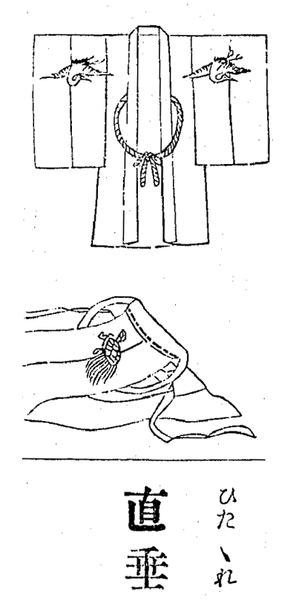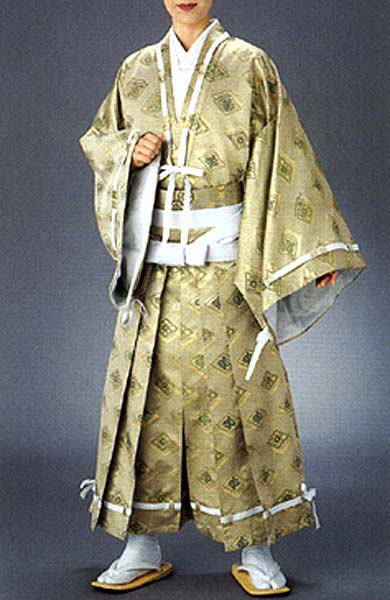Difference between revisions of "Hitatare"
(New page: ===History=== Between the 12th and 17th Century, the hitatare style of dress was popular. Unlike the common kimono worn in the later period, the hitatare was a two-piece costume, thou...) |
Weird Bird (talk | contribs) m (→Links: - Fixed some dead links via the Wayback Machine and removed a link that wasn't archived.) |
||
| (3 intermediate revisions by one other user not shown) | |||
| Line 1: | Line 1: | ||
| + | {{cleanup | ||
| + | |reason=Some information is copied directly from an external site | ||
| + | |date=March 2024 | ||
| + | }} | ||
| + | |||
===History=== | ===History=== | ||
| − | + | [[Image:302px-Hitatare.png|left|thumb|Drawing of Hitatare and matching [[Hakama]]]] | |
Between the 12th and 17th Century, the hitatare style of dress was popular. Unlike the common [[kimono]] worn in the later period, the hitatare was a two-piece costume, though comparably flowing and ample (Yoroi hitatarewas a snugger version for use under armor). This costume, for a possible frame of reference, is what most of the samurai wear in Japanese movies set prior to the Edo Period (the oft-mentioned Kagemusha, Ran, Throne of Blood, Heaven and Earth, ect…). Generally worn when in some 'official' capacity, the hitatare were normally adorned with the crest (or mon) of their immediate family or clan, or, in the case of relatives or direct retainers of the lord, the crest of the daimyô or shugo. Decorative bows also often adorned hitatare, normally worn on the breast. | Between the 12th and 17th Century, the hitatare style of dress was popular. Unlike the common [[kimono]] worn in the later period, the hitatare was a two-piece costume, though comparably flowing and ample (Yoroi hitatarewas a snugger version for use under armor). This costume, for a possible frame of reference, is what most of the samurai wear in Japanese movies set prior to the Edo Period (the oft-mentioned Kagemusha, Ran, Throne of Blood, Heaven and Earth, ect…). Generally worn when in some 'official' capacity, the hitatare were normally adorned with the crest (or mon) of their immediate family or clan, or, in the case of relatives or direct retainers of the lord, the crest of the daimyô or shugo. Decorative bows also often adorned hitatare, normally worn on the breast. | ||
===Links=== | ===Links=== | ||
| + | [[Image:Hitatare8675.jpg|thumb|modern example]] | ||
*[http://hattori.narod.ru/mka/patterns/hitatare.pdf Pattern] | *[http://hattori.narod.ru/mka/patterns/hitatare.pdf Pattern] | ||
*[http://www.iz2.or.jp/english/fukusyoku/busou/5.htm Pictures of Hitatare] | *[http://www.iz2.or.jp/english/fukusyoku/busou/5.htm Pictures of Hitatare] | ||
| − | *[http://www.samurai-archives.com/clothing.html history of Hitatare] | + | *[https://web.archive.org/web/20130416033813/http://www.samurai-archives.com/clothing.html history of Hitatare] |
| − | *[http://books.google.com/books?id=GLsbxozhjV8C&pg=PA142&lpg=PA142&dq=Hitatare&source=bl&ots=UzVOwd_LnR&sig=urcqGCLJSQAwB7JxdctAciasrwg&hl=en&sa=X&oi=book_result&resnum=9&ct=result#PPA5,M1 Book Excerpts | + | *[http://books.google.com/books?id=GLsbxozhjV8C&pg=PA142&lpg=PA142&dq=Hitatare&source=bl&ots=UzVOwd_LnR&sig=urcqGCLJSQAwB7JxdctAciasrwg&hl=en&sa=X&oi=book_result&resnum=9&ct=result#PPA5,M1 Book Excerpts] |
| − | |||
[[Category:Japanese Garb]] [[Category:Garb]] [[Category:How To]] | [[Category:Japanese Garb]] [[Category:Garb]] [[Category:How To]] | ||
| + | [[Category:Men's Garb]] | ||
Latest revision as of 22:17, 12 March 2024
| This article may require cleanup. The specific problem is: Some information is copied directly from an external site. Relevant discussion may be found on the talk page. Please help improve this article if you can. (March 2024) |
History

Between the 12th and 17th Century, the hitatare style of dress was popular. Unlike the common kimono worn in the later period, the hitatare was a two-piece costume, though comparably flowing and ample (Yoroi hitatarewas a snugger version for use under armor). This costume, for a possible frame of reference, is what most of the samurai wear in Japanese movies set prior to the Edo Period (the oft-mentioned Kagemusha, Ran, Throne of Blood, Heaven and Earth, ect…). Generally worn when in some 'official' capacity, the hitatare were normally adorned with the crest (or mon) of their immediate family or clan, or, in the case of relatives or direct retainers of the lord, the crest of the daimyô or shugo. Decorative bows also often adorned hitatare, normally worn on the breast.
